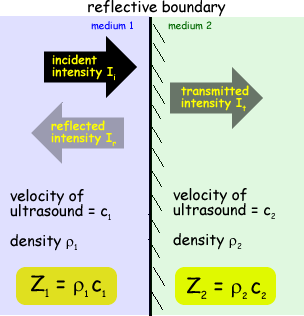Reflection of Ultrasound Waves
The strength of the reflected sound wave depends on the difference in "acoustic impedance" between adjacent structures. Acoustic impedance (Z) is defined as the product of density (
The fraction of the incident intensity that is reflected is given by the equation:
where
The greater the difference in acoustic impedance between two adjacent tissues the more ultrasound energy the boundary will reflect . Sound waves are propagated at a speed of approximately 340 m/s in air and 1540 m/s in soft tissues. This big difference means that if a coupling gel is needed between the body of the patient and the ultrasound transducer. The gel forces out the air between the body and the transducer window and replaces it with a medium that allows ultrasound to travel through it at a speed closer to that of the body. The difference in acoustic impedances of two soft tissues is small and only about one per cent of the energy of theultrasonic beam is reflected. However, this is sufficient to produce a detectable echo. More intense echoes are produced at 'bone-soft tissue' boundaries since the impedance difference is large. Similarly, an 'air-soft tissue' boundary reflects almost all of the incident pulse because of the large impedance differences. Therefore the presence of air within the body (ie in the lungs) prevents structures behind it from being examined. Various characteristic impedances are given for you to look at in the table below. In an examination you would always be given data to perform calculations but the general differences above would need to be known.
Note:
|
Follow me...
|







